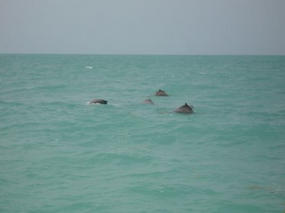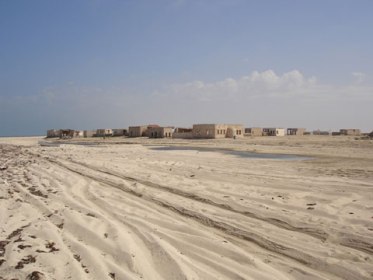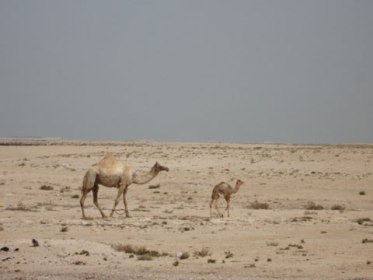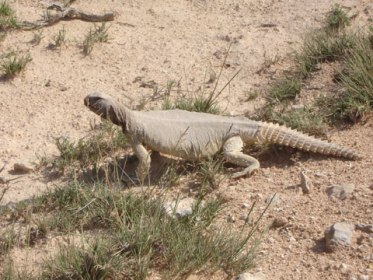About Qatar
|
Qatar
| |||||||
A view of Al Mafyar, a deserted village taken from the Island of Umm Tais
| Facts and Figures of Qatar | |
|
| |
A view of Al Mafyar, a deserted village taken from the Island of Umm Tais
The State of Qatar
Oil, Natural Gas and Economic Development The oil policy followed by the State aims at supporting and enhancing the production capabilities of oil and gas and expanding industrial projects that depend on these resources so as to diversify the sources of income and establish an appropriate economic base.
The oil policy followed by the State aims at supporting and enhancing the production capabilities of oil and gas and expanding industrial projects that depend on these resources so as to diversify the sources of income and establish an appropriate economic base.
In spite of the international economic developments, specially those related to supply and demand, which affected the oil sector, the State maintained its oil production objectives and meets the requirements of the overall development plans through oil exploration and oil field development.
Qatar has realised during the second half of 1999 1,8 billion US$ in oil revenues in view of recovery of oil prices in the international markets. The average daily oil production reached 675 thousand barrels in 1998. The average daily oil exports reached 461 thousand barrels in 1997 production amounted to 2,552 thousand metric tons in 1997, while the local consumption amounted to 971, 9 thousand metric tons in the same year.
The offshore gas field which was discovered in 1971 is situated in the North East of the Qatar Peninsula at a water depth of 15-70 meters, and covers an area of 6 thousand square kilometres which is equal to half of the land of the State. This field is believed to be the largest natural gas reserve in the world whereas its total reserves amount to more than 500 trillion cubic feet, while its recoverable reserves amount to 380 trillion cubic feet. It is also considered to be the largest single non-associated natural gas field in the world, making Qatar one of the world five countries with the biggest gas reserves.
In view of the large reserves of this field and the qualities of gas as a clean and safe source of energy to be depended upon for a very long time, the Qatar Gas and Petroleum Company has worked out a strategic plan to develop the field in specific phases and optimise the exporting
The average daily output of gas reached 1,482 million cubic feet in 1998, of which 691 million cubic feet are associated gas and 789 million cubic feet are non-associated.
Diplomatic Relations
Qatar maintains diplomatic ties with the majority of United Nation's Members through resident and non-resident representation. The State of Qatar has maintained diplomatic relations with nearly all Asian countries and regions represented by the embassies, consulates, permanent missions and representation offices of the Country.
Nature in Qatar Most of the wildlife indigenous to Qatar is typical of a desert environment, and consists of insects such as grasshoppers, crickets, scorpions and praying mantis. Lizards and geckos are common features of the country; as are small nocturnal mammals, such as desert hares and sand rats.
Most of the wildlife indigenous to Qatar is typical of a desert environment, and consists of insects such as grasshoppers, crickets, scorpions and praying mantis. Lizards and geckos are common features of the country; as are small nocturnal mammals, such as desert hares and sand rats.
In earlier times, herds of Arabian Oryx roamed the countryside, using the natural wells and oases as breeding and settling points. Sadly, this magnificent creature is now only to be found in captivity. The government has embarked upon a stringent Oryx breeding and conservation programme, with notable results.
Qatar is an excellent place for observing bird life, especially during the migratory months in spring and autumn. Throughout the year, sparrows, parakeets, gulls, cormorants and other sea birds can be found, but the population is significantly augmented by visiting species, taking advantage of the many fine trees and gardens that are cultivated in the towns to rest for a few days during their long journeys.
The best places for observing bird life are to be found just south of Doha, an area of effluent natural ponds, and around the Messaieed Sewage Works. There is a certain amount of marine life in Qatar's coastal waters, although this is more limited than one might expect, due to the shallowness of the waters and the high degree of salinity.
Crabs, lobsters and the famous Gulf Shrimp are common features of the coasts, as, less attractively, are jellyfish. In the deeper waters further offshore can be found hammour (grouper) - the most popular edible fish in the region -, channad, snapper, tuna and certain varieties of shark.
Culture of Qatar Volumes could be written about traditional Arab culture, as practised in the Gulf region (and, indeed, have been); we, however, are only able to give a glimpse of the major features.
Volumes could be written about traditional Arab culture, as practised in the Gulf region (and, indeed, have been); we, however, are only able to give a glimpse of the major features.
Gulf society is primarily tribal. Tribes are, in effect, extended families, and the family names that always in-corporate "Bin" (or son of) reflect this. Families are often named after a prominent leader from past times, for example Al-Mahmoud, or indeed Al-Thani. Individual male members of a tribe always carry their father's name, hence a typical person may be called Mohammed Bin Ahmed Al-Kuwari (Mohammed, Son of Ahmed from the Al-Kuwari Family). Women are known as daughter of, hence Mariam Bint Ahmed Al-Kuwari (Mariam, daughter of Ahmed Al-Kuwari). Tribes are divided into clans and then into households. The latter include groups of single families. The concepts of family and of honour are very important in Arab culture and society. The family will usually band together on principle over issues of conflict.
Unlike in Western society, it is deemed preferable to marry within your tribe and to find a spouse who is as closely related as possible, although naturally siblings may not marry. Marriage is a family and business matter, and most marriages are arranged. In the past, girls as young as fourteen could be married, but the tendency in recent years has been to wait until the girls are older, especially if she is studying. Qatari weddings are an elaborate, ritualistic affair, lasting several days and involving a great deal of ceremony, most of which is conducted separately by women and men.
Hospitality is a major feature of Arab culture and society. Guests are always made welcome and be offered refreshment as a matter of course.
Religion The official religion of Qatar is Islam, and the vast majority of Qatari's are Sunni Moslems. The country adopted Islam without any controversy in the 7th century and has remained devoted to the faith ever since.
The official religion of Qatar is Islam, and the vast majority of Qatari's are Sunni Moslems. The country adopted Islam without any controversy in the 7th century and has remained devoted to the faith ever since.
There are five main pillars or tenets of the Islamic faith, namely:
- The Islamic profession of faith (shahhada).
- Prayer (salah) - to be performed five times daily.
- Zakat (alms for the poor, levied in the form of a religious tax).
- Fasting, which takes place annually during the Holy Month of Ramadan between dawn and dusk.
- The pilgrimage to Mecca or Hajj, which must be performed at least once in a lifetime, if possible.
Unlike other cultures and religions, Moslems follow a lunar calendar, which means that no prayer time or religious festival is fixed. Generally, key events, such as Ramadan and the Eid Al Fitr festival which immediately follows, shift backwards by 10 days per year, while prayer times are determined by the hours of dawn and dusk.
Public holidays in Qatar, apart from National Day, are also religious holidays. The main ones are Eid Al Fitr (which follows Ramadan) and Eid Al Adha, which follows 70 days after Eid Al Fitr.
It is expected that non-Muslims resident in Qatar should respect the laws and customs of the religion. This means adhering to modest standards of dress and behaviour in public, in addition to not mocking or denigrating Islam in any way.
Camels near the north road on the outskirts of Doha
| Doha: the Capital of Qatar | |
The port city of Doha, on the East Coast of Qatar, is the capital and major commercial centre of the country. More than 70 percent of the population live there. Most of the rest live in the industrial town of Umm Said, the oil-field region of Dukhan, and the East Coast town of Al-Wakrah in the south and Al-Khor in the north of Doha.
In winter months, it has a perfect climate and with more hotels being built, Doha has the necessary infrastructure to host the most demanding international sport and non-sports events. |
A lizard caught on camera at Al Shamal, close to Umm Tais Island

| مدينة الدوحة :عاصمة دولة قطر | |
تقع مدينة الدوحة على الساحل الشرقي من قطر وتعتبر العاصمة والمركز التجاري العام الهام للبلاد. ويقطن المدينة أكثر من 70 في المائة من إجمالي السكان ، والبقية يقيمون في منطقة ميسعيد الصناعية ومنطقة حقول النفط في دخان ومدينة الوكرة التي تقع على الساحل الشرقي في الجنوب ومدينة الخور شمال الدوحة. إن مدينة الدوحة وهي العاصمة التي تتراوح بين التقاليد والتقدم حيث كانت سابقاً تضم أكواخاً لصيد الأسماك أصبحت الآن تضم مباني حديثة . ويتم كل يوم تقريبا ، بناء مبنى أو مبنيين سكنيين لعائلات. وفي الوقت الحاضر فإن حركة البناء مستمرة . وفي الساعات الليل تضئ آلاف الأنوار مدينة الدوحة بأكملها. وفي أشهر الشتاء يكون الطقس ممتازا ومع بناء المزيد من الفنادق. فإن مدينة الدوحة تتمتع ببنية تحتية تؤهلها لاستضافة الأحداث الرياضية الدولية. |
This is one of my favorite images

 Evidence of early civilisation in Qatar stretches back several thousands years, with pottery shards dating from around BC 2,500 having been found at more than one location. Qatar's relationship with the ancient Dilmun civilisation is to further study. In the 5th century BC, the Greek historian Herodotus referred to the original seafaring inhabitants of Qatar. Qatar was famed for its weaving and embroidery, especially its cloaks.
Evidence of early civilisation in Qatar stretches back several thousands years, with pottery shards dating from around BC 2,500 having been found at more than one location. Qatar's relationship with the ancient Dilmun civilisation is to further study. In the 5th century BC, the Greek historian Herodotus referred to the original seafaring inhabitants of Qatar. Qatar was famed for its weaving and embroidery, especially its cloaks. Qatar has enjoyed political stability and economic prosperity since independence in 1971 and is currently evolving into and modern State. H.H. the Emir, who assumed power in 1995, abolished censorship by disbanding the information Ministry in 1996. The new freedoms were further enhanced with the establishment of an independent Arab satellite news channel called Al-Jazeera Satellite Channel, the first of its kind in the Arab World. The Advisory Council, invited representatives from the press and the Ministry of Justice to help draft a press and publications law that would further cement the media's newly gained freedoms.
Qatar has enjoyed political stability and economic prosperity since independence in 1971 and is currently evolving into and modern State. H.H. the Emir, who assumed power in 1995, abolished censorship by disbanding the information Ministry in 1996. The new freedoms were further enhanced with the establishment of an independent Arab satellite news channel called Al-Jazeera Satellite Channel, the first of its kind in the Arab World. The Advisory Council, invited representatives from the press and the Ministry of Justice to help draft a press and publications law that would further cement the media's newly gained freedoms.

 Qatar is a peninsula, 11,437 square km in area, which project from the Arabian mainland. It is approximately 160 km in length and 80 km in width at its widest point. Overall, the country is very flat, rising to only 110 m at its highest point, and the land mass largely consists of scrubby desert terrain, covered in sand and loose gravel. The country is largely formed of limestone deposits and clays, laid down in various geologically defined eras. A broad North-South arch dominates the structure of the land, with the Dukhan anticline to the west, while the coastal areas are mostly characterised by salt flats, with an area of high sand dunes in the southeast. Lying in the path of strong prevailing southeasterly winds.
Qatar is a peninsula, 11,437 square km in area, which project from the Arabian mainland. It is approximately 160 km in length and 80 km in width at its widest point. Overall, the country is very flat, rising to only 110 m at its highest point, and the land mass largely consists of scrubby desert terrain, covered in sand and loose gravel. The country is largely formed of limestone deposits and clays, laid down in various geologically defined eras. A broad North-South arch dominates the structure of the land, with the Dukhan anticline to the west, while the coastal areas are mostly characterised by salt flats, with an area of high sand dunes in the southeast. Lying in the path of strong prevailing southeasterly winds.


 Doha, the Capital between tradition and progress where formerly only fishing huts could be found, is now lined by modern architecture. Nearly every day single and two family houses are built. At present this building boom continues. At night, thousands of lights illuminate the whole city of Doha.
Doha, the Capital between tradition and progress where formerly only fishing huts could be found, is now lined by modern architecture. Nearly every day single and two family houses are built. At present this building boom continues. At night, thousands of lights illuminate the whole city of Doha.